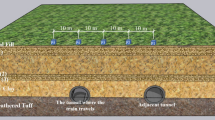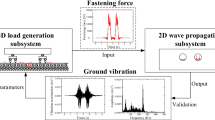Abstract
An experimental study and theoretical analysis were carried out to explore the ground-borne vibration generated by elevated high-speed railway in rock strata. Taking a typical rail line constructed on rock area in China as the research object, a set of field tests was performed on Rizhao-Lankao High-Speed Railway, the bridge and ground vibrations were measured as trains passed at 330–340 km/h, then the transferring law and spatial distribution under individual frequencies were investigated. The experiment results indicate that the bridge frequency spectrum exhibited relatively high-frequency vibration peaks caused by short-wavelength irregularity; ground vibration farther than 30 m away can be amplified with a higher frequency and numerous components. Furthermore, the wave propagation equation of a stratified rock strata was established based on direct-stiffness method to explore the vibration attenuation rules via frequency-domain analysis. It is found that the rock area has a weaker correlation between vibration transmissibility and frequency, thicker and harder rock strata loss their vibration attenuation capacity. It can be concluded that the high-speed railways induced vibration on rock strata shows a wide frequency band and large amplitude, the design of reducing vibration aimed at specific frequency is important according to next more detailed numerical study.
摘要
本文以典型基岩浅埋地层的日兰高铁为研究对象,在线路联调联试阶段对某32 m 简支梁桥区段展开现场测试。 采用时频方法对桥梁和地面振动响应进行分析,研究了弹性波在特殊地质条件下的传递规律与衰减特性。 结果表明:距离桥墩较远的30 m 范围之外的地面振动幅值出现放大现象; 岩石介质高速铁路环境振动具有宽频段、大幅值两大特征; 土-岩二元结构地层与岩石一元结构地层的系统传递特性差异较大,岩层越厚、等级越坚硬的岩石介质呈现振动传递率与频率的弱相关性,振动衰减能力下降。
Similar content being viewed by others
References
Department of Transportation Federal Railroad Administration. High-speed ground transportation noise and vibration impact assessment [R]. Washington, D.C., 1998.
NTOTSIOS E, THOMPSON D, HUSSEIN M. The effect of track load correlation on ground-borne vibration from railways [J]. Journal of Sound and Vibration, 2017, 402: 142–163. DOI: https://doi.org/10.1016/j.jsv.2017.05.006.
YANG Na, GUO Ting, SUN Guo-zhong. Train-induced vibration on elevated railway station [J]. Journal of Central South University, 2013, 20(12): 3745–3753. DOI: https://doi.org/10.1007/s11771-013-1903-2.
MOHAMMED M M, ROSLAN H, FIRAS S. Assessment of rapid impact compaction in ground improvement from in situ testing [J]. Journal of Central South University, 2013, 20(3): 786–790. DOI: https://doi.org/10.1007/s11771-013-1549-0.
GUPTA S, DEGRANDE G, LOMBAERT G. Experimental validation of a numerical model for subway induced vibrations [J]. Journal of Sound and Vibration, 2009, 321(3–5): 786–812. DOI: https://doi.org/10.1016/j.jsv.2008.10.014.
CONNOLLY D, GIANNOPOULOS A, FORDE M C. Numerical modelling of ground borne vibrations from high speed rail lines on embankments [J]. Soil Dynamics and Earthquake Engineering, 2013, 46: 13–19. DOI: https://doi.org/10.1016/j.soildyn.2012.12.003.
CONNOLLY D P, KOUROUSSIS G, WOODWARD P K, GIANNOPOULOS A, VERLINDEN O, FORDE M C. Scoping prediction of re-radiated ground-borne noise and vibration near high speed rail lines with variable soils [J]. Soil Dynamics and Earthquake Engineering, 2014, 66: 78–88. DOI: https://doi.org/10.1016/j.soildyn.2014.06.021.
CORREIA DOS SANTOS N, BARBOSA J, CALCADA R, DELGADO R. Implementation of a three dimensional time domain formulation for the prediction of vehicle induced vibrations [C]// The Tenth International Conference on Computational Structures Technology. 2010.
CORREIA DOS SANTOS N, BARBOSA J, CALÇADA R, DELGADO R. Track-ground vibrations induced by railway traffic: Experimental validation of a 3D numerical model [J]. Soil Dynamics and Earthquake Engineering, 2017, 97: 324–344. DOI: https://doi.org/10.1016/j.soildyn.2017.03.004.
JU S H, LIN H T, CHEN T K. Studying characteristics of train-induced ground vibrations adjacent to an elevated railway by field experiments [J]. Journal of Geotechnical & Geoenvironmental Engineering, 2007, 133(10): 1302–1307.
XIA H, CHEN J G, XIA C Y. An experimental study of train-induced structural and environmental vibrations of a rail transit elevated bridge with ladder tracks [J]. Journal of Rail & Rapid Transit, 2010, 224(3): 115–124.
ZHAO Cai-you, WANG Ping, XING Meng-ting, YI Qiang, WANG Liu-cong. Reduction of ground-borne vibrations from rail lines on viaducts by means of elastic anti-vibration mats [J]. Journal of Rail & Rapid Transit, 2019, 233(5): 550–565.
LI Xiao-zhen, ZHANG Zhi-jun, ZHANG Xun. Using elastic bridge bearings to reduce train-induced ground vibrations: An experimental and numerical study [J]. Soil Dynamics and Earthquake Engineering, 2016, 85: 78–90. DOI: https://doi.org/10.1016/j.soildyn.2016.03.013.
THOMSON W T. Transmission of elastic waves through a stratified solid medium [J]. Journal of Applied Physics, 1950, 21(2): 89–93. DOI: https://doi.org/10.1063/1.1699629.
KIM D S, LEE J S. Propagation and attenuation characteristics of various ground vibrations [J]. Soil Dynamics and Earthquake Engineering, 2000, 19(2): 115–126. DOI: https://doi.org/10.1016/S0267-7261(00)00002-6.
GUPTA S, STANUS Y, LOMBAERT G, DEGRANDE G. Influence of tunnel and soil parameters on vibrations from underground railways [J]. Journal of Sound and Vibration, 2009, 327(1, 2): 70–91. DOI: https://doi.org/10.1016/j.jsv.2009.05.029.
ZHANG Bo, LI Shu-cai, ZHANG Dun-fu, XUE Yi-guo, WANG Xi-ping. Research on rock environments vibration response induced by metro trains in rock media [J]. Chinese Journal of Rock Mechanics and Engineering, 2011, 30(S1): 3341–3347. (in Chinese)
ZHANG Bin, WANG Jian-li, WANG Jian, ZHANG Qi-le, ZHANG Ning. Test analysis of Qingdao rock site vibration transmission characteristics under metro train excitations [J]. Urban Rapid Rail Transit, 2018, 31(3): 40–45. (in Chinese)
AUERSCH L. Ground vibration due to railway traffic—The calculation of the effects of moving static loads and their experimental verification [J]. Journal of Sound and Vibration, 2006, 293(3–5): 599–610. DOI: https://doi.org/10.1016/j.jsv.2005.08.059.
GB 10070–99. National Environmental Protection Agency. Standard of environmental vibration in urban area [S]. Beijing: Press of China Standards, 1989.
JGJ/T 170–2009. Ministry of Housing and Urban-Rural Development of the People’s Republic of China. Standard for limit and measuring method of building vibration and secondary noise caused by urban rail transit [S]. Beijing: China Architectures and Building Press, 2009.
LU W, YAO K, WANG S, et al. Comparison of frequency weighting curves in two versions of ISO 2631-1 [C]// Proceedings of the Chinese Society of Environmental Science. Beijing, 2009: 294–298.
ISO 2631/1-1997. Mechanical vibration and shock—Evaluation of human exposure to whole-body vibration-Part 1: General requirement [S].
THOMSON W T. Transmission of elastic waves through a stratified solid medium [J]. Journal of Applied Physics, 1950, 21(2): 89–93. DOI: https://doi.org/10.1063/1.1699629.
RIZZI S A, DOYLE J F. Spectral analysis of wave motion in plane solids with boundaries [J]. Journal of Vibration and Acoustics, 1992, 114(2): 133–140. DOI: https://doi.org/10.1115/1.2930241.
KAUSEL E, ROESSET J M. Stiffness matrices for layered soils [J]. International Journal of Rock Mechanics and Mining Sciences & Geomechanics Abstracts, 1983, 20(1): A7. DOI: https://doi.org/10.1016/0148-9062(83)91665-0.
Funding
Project(2016YFE0205200) supported by the National Key Research and Development Program of China; Projects(U1734207, 51978585) supported by the National Natural Science Foundation of China
Author information
Authors and Affiliations
Contributions
WANG Ping provided the concept of manuscript. XING Meng-ting analyzed the calculated results and wrote the first draft of the manuscript. ZHAO Cai-you conducted the literature review and edited the draft of manuscript. WU Xue and KANG Xiu-shan analyzed the measured data. All authors replied to reviewers’ comments and revised the final version.
Corresponding author
Additional information
Conflict of interest
XING Meng-ting, WANG Ping, ZHAO Cai-you, WU Xue and KANG Xiu-shan declare that they have no conflict of interest.
Rights and permissions
About this article
Cite this article
Xing, Mt., Wang, P., Zhao, Cy. et al. Ground-borne vibration generated by high-speed train viaduct systems in soft-upper/hard-lower rock strata. J. Cent. South Univ. 28, 2140–2157 (2021). https://doi.org/10.1007/s11771-021-4758-y
Received:
Accepted:
Published:
Issue Date:
DOI: https://doi.org/10.1007/s11771-021-4758-y




